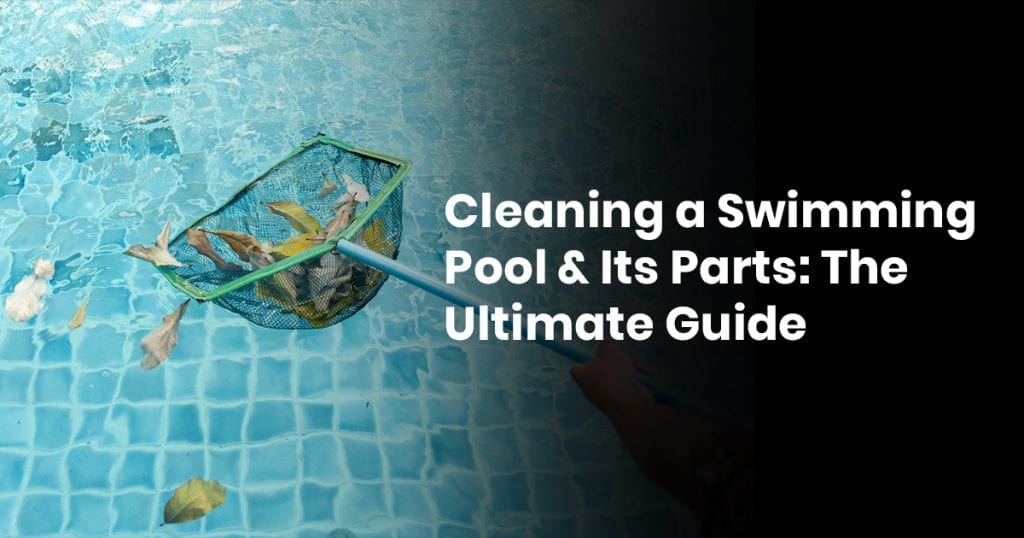Buying a swimming pool is a major investment.
Not only is a pool a serious financial outlay, it is also an investment of personal time. Many home owners do not realize how much time maintaining a pool properly takes, nor what tools and methods can reduce that time the most.
Failing to do good research before you install a pool means you may end up with an unpleasant surprise when your water quality falters and your pool goes from clear and pristine to cloudy, green and yucky.
Performing routine pool maintenance – especially cleaning – is essential to having a beautiful, clean pool that you want to spend your summer in and around.
However, if you don’t know the basics then taking care of your pool can be a daunting task.
In this guide, we’ll break down the correct ways to clean your residential swimming pool and discuss the ins, outs and best practices for each.
How often should you clean your pool?
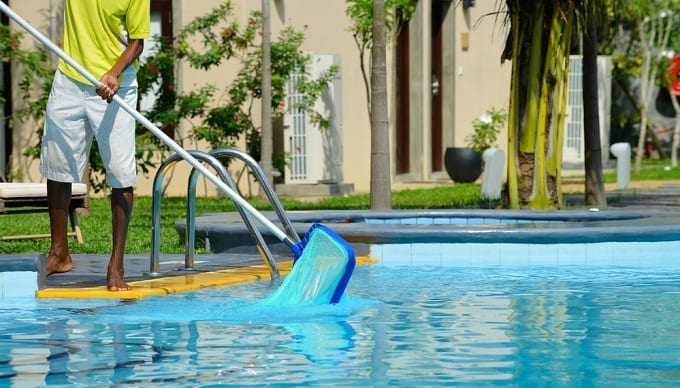
This is the most-often asked question at pool stores – and the answer isn’t the same for everyone.
Cleaning your pool isn’t just a single task, it involves many tasks that should be done correctly – and on a consistent schedule.
Failing to keep up with pool cleaning tasks means that your pool risks a multitude of problems, ranging from poor water quality to pump and filter damage. In some cases, you can permanently damage your pool.
Yes, it will take time away from your summer fun, but there is nothing that ruins time off like a pool that looks gross or summer money that has to be spent on unnecessary replacement of parts.
The short answer is that there are simple cleaning tasks that need to be done daily, twice weekly, weekly, monthly and seasonally.
Making sure you do all of these things regularly and with the right tools and supplies will keep your pool looking great, and minimize unforeseen maintenance problems.
Here are the cleaning and maintenance tasks that your pool needs to look great and remain safe.
Daily POOL CLEANING TASKS
Every day: check your pool. If you travel for a living, then place a webcam inside your window pointing out to your pool.
This is a good safety measure anyway, since things can go wrong and you want to catch problems quickly.
From a cleaning standpoint, even little bits of dirt and debris can quickly turn your pool into a big mess.
Every day you should skim your pool with a net (or if you aren’t around, a robotic pool skimmer) to collect leaves, bugs, anything floating in your pool. You want to do this daily to prevent those items from water logging and sinking to the bottom of your pool, where they can do harm.
Also, floaters will eventually clog your pool filter and cause your pool pump to not work as efficiently, which further degrades the quality of your pool water and wasted electricity.
Twice Per Week
Keeping your pool’s chemistry just right plays a huge role in keeping your pool clean and healthy.
Check the three most important chemical levels in your pool – pH, salt (if a salt water system) and free chlorine – twice a week.
TIP: Use a wifi-connected floating chem test unit to keep on top of this if you aren’t at home during the week.
If you find that your water quality is off, adjust it by adding the right chemicals in the right amounts, as follows:
- to lower your pH/make it more acidic, add muriatic acid
- to increase your pH/make it more alkaline, add baking soda
- to increase chlorine, add liquid chlorine or add dry shock to your pool
Keeping these basic water quality parameters in check will help keep algae in check as well.
While you’re testing your pool it’s a good time to skim debris from the surface and clean your filter skimmer baskets.
Weekly POOL CLEANING TASKS
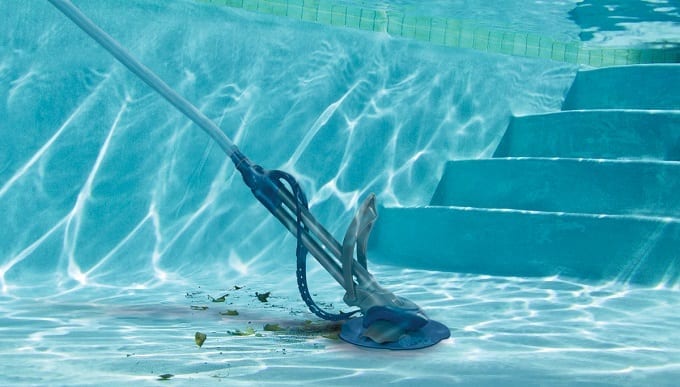
At least once per week, vacuum your pool’s floor.
For tree-covered pools this can be done daily during leaf-dropping season, but for busy schedules, make sure you’re running your pool vacuum at least once per week.
Vacuuming your pool will collect debris, dirt and algae that have sunk to the bottom of the pool.
Routine vacuuming of leaves will also keep pH levels in check and reduce the amount of chemicals you need.
Other tasks that should be completed weekly include:
- scrubbing pool walls and the tile/wall at the water line
- shocking the pool if needed
- adding algaecide
Monthly POOL CLEANING TASKS
There are two tasks you should do monthly to keep your pool clean.
First, clean your pool deck. A dirty pool deck will directly contribute to a dirty pool.
Dirt, algae, debris, food and spilled beverages all stick to pool users feet and get deposited into the pool or wash into the pool during storms – or just end up there from wind, splashing and play.
Use a good deck cleaner and scrub your deck well to break up any stuck on debris.
If you have a mold issue on your pool deck, the buy a pressure washer to remove buildup.
Once your deck is clean, move on to check your pool pumps and pool filters.
Dirty pool filters cannot clean your pool water, so make sure you either change or clean your pool filters once a month.
Different types of pool filters have different cleaning and replacement requirements, so make sure you follow manufacturer directions.
Periodic TASKS
Every two or three months, you should shut down your pool temporarily for additional, more intensive maintenance and cleaning tasks.
First, take a sample of your pool water and deliver it to a water testing professional for a more thorough and precise analysis of your pool chemicals.
Then, close your pool for a couple of days and dose your pool with a metal remover.
Metals can blow into your pool from dust in the air, and even tap water carries metal in it.
Metals in your pool are not harmful but do impact the chemical balance in your water.
Let these chemicals work for a couple of days, then vacuum your pool.
Of course, these are a general list of pool cleaning tasks, you may want to do more, or perform some of these task more frequently.
We’ve simply provided the basic schedule to keep your life easy, and still have a clean and healthy pool.
Pool Robots: How Well Do They work?
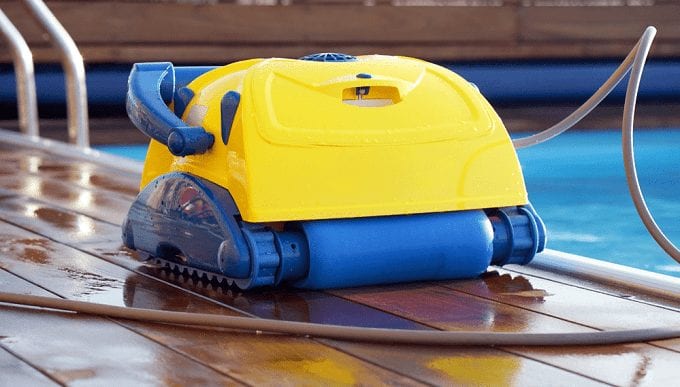
Pool robots are now more than 10 years old and have evolved from something that breaks all the time into an amazing, reliable tool to take care of your daily and weekly pool cleaning tasks without breaking a sweat – or even requiring you to be home.
Robotic pool cleaners are a great answer to the age old question, “What if guests unexpectedly arrive and my pool hasn’t been cleaned?”
Automatic pool cleaners have been around for years. They make cleaning your pool relatively easy and effortless.
Most pool owners know about suction-side or pressure-side cleaners. These are “old school” way of automatically cleaning your pool.
However, they do require a bit of hand-holding and oversight.
These both work with your filter system and are useful, but if you can’t keep an eye on them they can damage your filter and pump systems and miss more than a few spots – especially stairs and vertical walls.
If you truly want a “set it, and forget it” option for cleaning your pool, then a pool robot is your answer.
The automatic vacuums are like the Roomba for your pool, and they are just as smart.
Like most other automatic pool cleaners, pool robots skim the bottom of your pool for debris, dirt and algae.
Many smart pool robots are able to map the shape of your pool, so to speak, and learn the most efficient way to clean your pool, around stairs, ladders and other features.
For the most part, a pool vacuum is a great way to accomplish a majority of your pool cleaning tasks.
It won’t scrub the walls, but you shouldn’t have to worry about vacuuming on a weekly basis.
You can even set your pool robot to clean on a particular schedule, or set it to run after a party or a time when you are planning on having lots of people in your pool.
The first few times that you use a pool robot, you may want to keep an eye on it, just to make sure that it doesn’t get tangled on anything.
The downfall of a pool robot? The cost. Pool robots are still pretty new to the market, so they can be pricey.
And like any sort of technology, you get what you pay for. To make the most of your money, pay a little more and buy a robot that has a good warranty.
Robot vs. Manual Cleaning
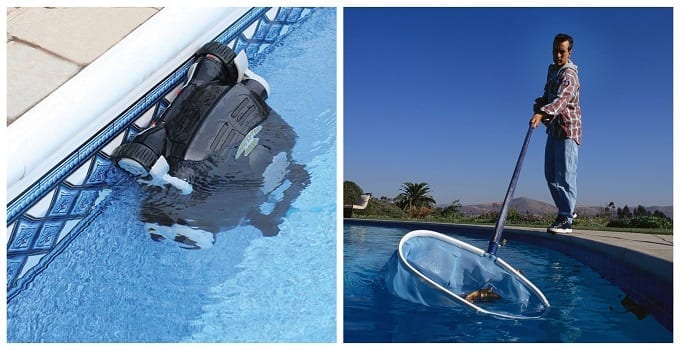
It is important to remember that the pool robot isn’t a cure-all for keeping your pool clean.
Yes, it can definitely alleviate daily and weekly cleaning tasks, but you still have to put in some manual labor to keep your pool in great shape.
In many cases, manual cleaning, while more time intensive, is a better option.
Pool Robots
The main benefit to using a pool robot is the freedom and schedule flexibility it gives a pool owner.
You can ensure a clean pool bottom without having to make much effort or even being there in person every day.
Just turn on the robot and let it learn your pool – and after a while it will do most of the daily and weekly cleaning work on its own.
Additionally, a pool robot is not intrusive to pool activities. You can stop and park it and set it to run on a schedule that works best for you.
And if you need to alter the schedule, it is easy to run most robotic pool cleaners for a cycle outside of their schedule.
There are a couple of cons with owning a pool robot, though, that you need to keep in mind.
The first is upfront cost. Pool robots are pricy, especially when you compare to the cost of traditional automatic pump-driven pool cleaners, side cleaners and pool vacuums.
Second, your pool robot will probably only vacuum the floor of your pool and part of the sides and steps really well.
In order to get to 100% of your pool walls, steps and deck of your pool, you’ll need to employ the old fashioned scrub brush method.
Finally, most pool robots come with brushes made for a particular pool surface type. Be careful when you shop to select one designed for an above ground or inground pool.
Some manufacturers also offer suface options, so make sure you do your research and get the right robot for your pool’s surface.
Manual Cleaning
Just like with a pool robot, there are pros and cons to manual cleaning.
A couple of positives about manual cleaning, first, is cost. There is something to be said for the inexpensive traditional tools.
Yes, you will need a manual vacuum and a scrubbing brush, but the cost of the few manual tools that you will need is far less than the cost of a pool robot.
And, don’t forget: most pool robots do not clean 100% of the sides of your pool, so you still need to do some manual work anyway.
The other benefit to hand cleaning is that there are fewer parts and computers to deal with.
You don’t have to worry about replacing expensive parts or a warranty running out with your scrub brush, or the vacuum brush.
The biggest con of manual cleaning is the time it will take you.
Manual cleaning is truly a chore that can take 20-30 minutes a day plus 30-45 minutes per weekend – time that you would rather spend doing other things.
However, you are still going to have to do some of the manual work, even with a robot. A robot only reduces the amount of time you’ll spend cleaning your pool.
How to Clean Your Pool After Draining
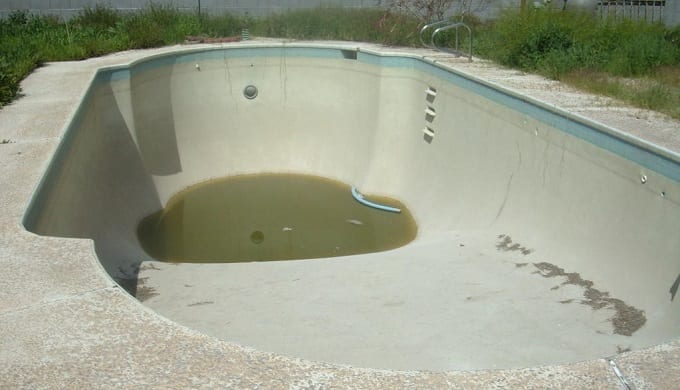
Draining a pool completely is NOT something you should do on your own.
You can partially drain your pool – maybe reduce the volume by 20% – as part of a winterizing process, but for the most part, draining your pool is not something that should be done on a regular basis.
That said, there are a few pool issues that cannot be resolved with sweat and pool chemicals.
For example, if you’ve inherited a pool from a previous homeowner, they may have let the pool stagnate.
If your winterizing process wasn’t very good, you may find that your pool is a green slimy mess or at worst, a stinky, black lagoon.
In these cases, your best bet for cleaning your pool just may be completely draining and acid washing the surface.
Keep in mind, however, this is a pretty drastic measure and it isn’t something you should do under normal conditions.
A Drain and Clean, as it is called, is for serious cleaning needs. The process can damage your pool, so only proceed if it is absolutely necessary.
Warning: removing all the water from a gunnite, concrete or hard-sided pool can cause the catastrophic failure of the structure and/or serious surface damage. This is because most stone pool structures are designed to be held in place by the weight of the water itself.
The drain and clean process is technically an acid wash plus the removal of a thin layer of plaster on the surface of your pool.
This process is highly efficient at removing stains, years of algae build-up, and mineral build-up. It is a process that can be accomplished by homeowners, using a substantial amount of care and caution.
However, this is one of those pool cleaning tasks that you may want to leave to the professionals.
If you want to give it a try yourself, here are the steps to follow.
Drain and CLEAN PROCESS
You can drain the pool using the built in drain or use a submersible pump.
Either way, this process will take a day or two.
While the pool is draining, scrub the walls and pool surfaces to break off build up and residue and debris.
Hose down the walls periodically to ensure that the build-up doesn’t bake on to the walls or floor.
Before you add the acid, make sure that you allow the inside of the pool to completely dry. Mixing acid with water can be dangerous.
Add the acid
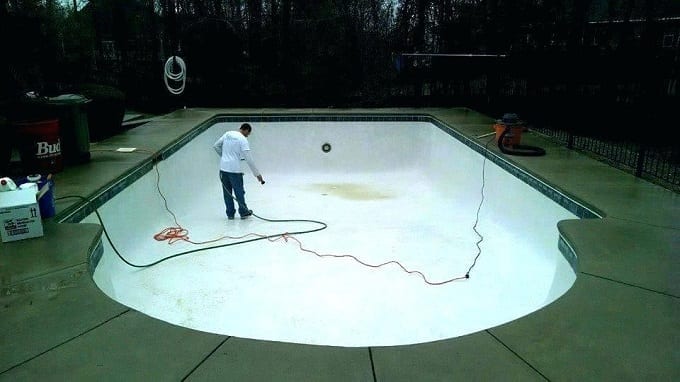
You’ll be using Muriatic Acid, which can burn skin and irritate eyes. Make sure you wear long pants, long-sleeved shirts, boots, and eye protection.
The easiest way to get the acid on all surfaces of the pool is to use a chemical sprayer (find one at the hardware store or garden store).
Follow the mixing instructions that come with the acid, and remember, the weaker the acid solution that you can use, the better.
Start the process on the deep end of the pool near the drain, working towards the shallow end. Apply acid to a small section and then rinse.
Leaving the acid on the pool surface can damage the plaster. Repeat this process around the pool, until the whole pool is cleaned.
Neutralize THE ACID
The bottom of your pool will have a small layer of slightly acidic water.
Before you pump this out, you will need to neutralize the water. Soda ash is a great option for neutralizing acid, and it is fairly inexpensive.
Use a pH test kit to ensure that the pH of the waste water in the pool is around 7.2.
Pump and rinse
Pump out all of the waste water, and rinse completely to ensure that all acid, and debris have been removed from the pool.
This process may require you to rinse the pool completely a couple of times.
However, a good rinse will ensure that you don’t have to worry about your pool quickly turning into a green slimy mess again.
Refill
This process can take a few days. Use a new garden hose to fill. If you want the process to go quicker, use two garden hoses.
Once your pool is refilled, check your water chemistry, treat as necessary to bring the water to good swimming conditions, and shock your pool with a good dose of chlorine.
Allow the pool to stabilize for a day or two before you enjoy.
Conclusion
Keeping your pool clean is an important part of owning a pool.
Sure, we all love to think that a pool is just fun and games, but a dirty, slimy, green pool can make the fun and games come to a quick stop.
Good pool maintenance and cleaning will ensure that from year to year, your pool is an amenity for your home that you will enjoy without too much extra work.

